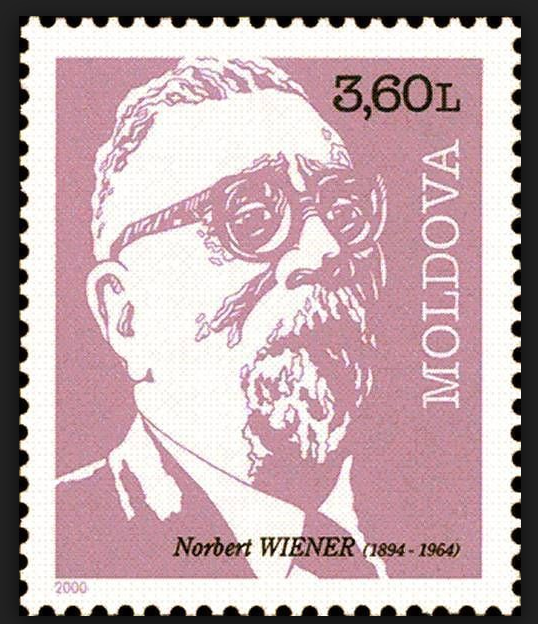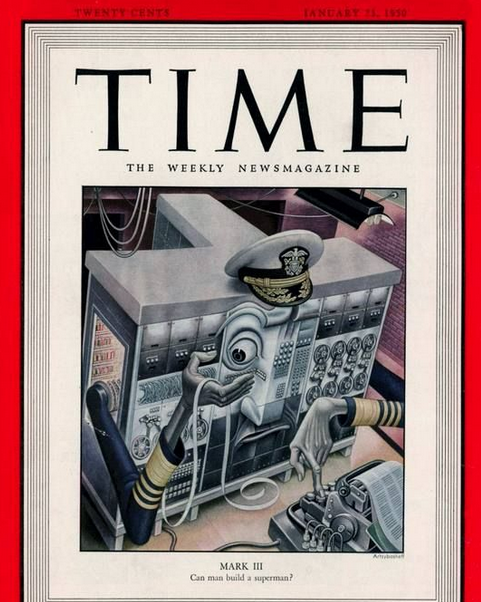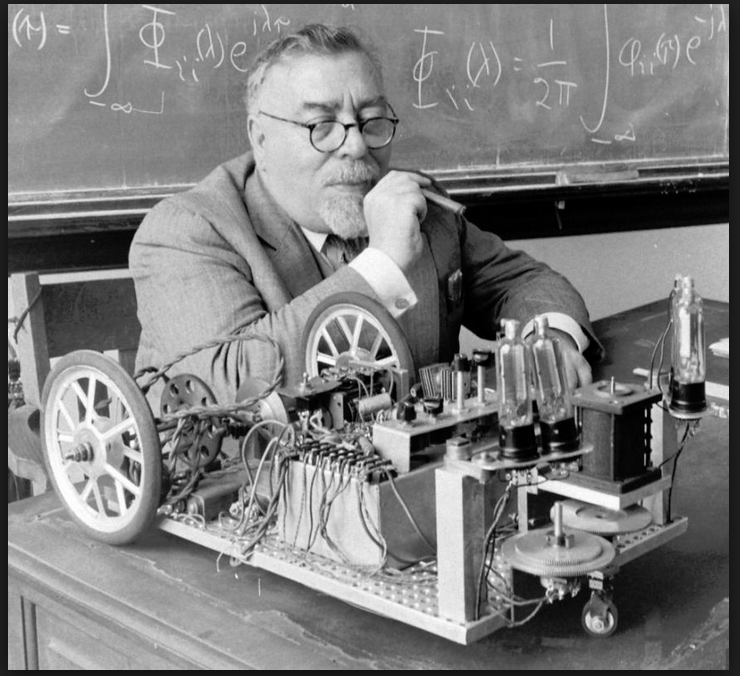The Human Uses of Google-Built Things
 I have been thinking this week - for two reasons - a good deal about Norbert Wiener. The first reason is simple: in the history of technology course I'm teaching, we're talking about the interactions between people and machines (mostly, computers) in advance of discussing the origins of the Internet. But the news that Google is planning to develop a new generation of driverless cars, ones that function without input from people (a video showing the prototype is here) also got me thinking more closely about the child prodigy turned MIT mathematician.Intellectually, Norbert Wiener was most closely associated with the development and popularization of cybernetics. Stemming from the Greek word kybernētēs for pilot or steersman, Wiener defined cybernetics as “the science of control and communication in the animal and the machine.” in which complex systems could be treated as self-regulating entities controlled by feedback. A key to this was “negative feedback,” in which comparison of a machine’s interim state with the path to its desired state generates signals which can be used to direct its progress. ((Consider a simple furnace connected to a thermostat. When it gets cold, the thermostat “communicates” this fact to the furnace which then turns on. While the room is heated, the thermostat monitors temperature, “telling” the furnace to shut off at a pre-selected temperature.)) Feedback and self-regulation sat at the heart of Wiener's conceptualization of cybernetics.
I have been thinking this week - for two reasons - a good deal about Norbert Wiener. The first reason is simple: in the history of technology course I'm teaching, we're talking about the interactions between people and machines (mostly, computers) in advance of discussing the origins of the Internet. But the news that Google is planning to develop a new generation of driverless cars, ones that function without input from people (a video showing the prototype is here) also got me thinking more closely about the child prodigy turned MIT mathematician.Intellectually, Norbert Wiener was most closely associated with the development and popularization of cybernetics. Stemming from the Greek word kybernētēs for pilot or steersman, Wiener defined cybernetics as “the science of control and communication in the animal and the machine.” in which complex systems could be treated as self-regulating entities controlled by feedback. A key to this was “negative feedback,” in which comparison of a machine’s interim state with the path to its desired state generates signals which can be used to direct its progress. ((Consider a simple furnace connected to a thermostat. When it gets cold, the thermostat “communicates” this fact to the furnace which then turns on. While the room is heated, the thermostat monitors temperature, “telling” the furnace to shut off at a pre-selected temperature.)) Feedback and self-regulation sat at the heart of Wiener's conceptualization of cybernetics. During World War Two, the application of cybernetic thinking Wiener was most involved with aimed to improve the accuracy of anti-aircraft fire. To do this best meant imagining the human components of the system - pilots and gunners - as machines whose behavior could be calculated and predicted. People were seen as “information processing systems” who interacted with other mechanical parts of the overall system. Cybernetics was fundamentally about the communications and controls between the various parts of the system which was comprised of person-machine interactions.With its focus on feedback, dynamic equilibrium, and the interplay between natural and artificial systems, cybernetics emerged out of military R&D efforts to become a "universal discipline" for the Cold War. ((Geof Bowker, “How to Be Universal: Some Cybernetic Strategies, 1943-1970,” Social Studies of Science, 1993, 23, 1: 107-27.)) Wiener, morally discomfited with military research, hoped that cybernetics might play a powerful and positive role in postwar biology, computer design, physiology, and even religion and politics. He promoted cybernetics in articles and books, including (the controversially named) The Human Use of Human Beings.
During World War Two, the application of cybernetic thinking Wiener was most involved with aimed to improve the accuracy of anti-aircraft fire. To do this best meant imagining the human components of the system - pilots and gunners - as machines whose behavior could be calculated and predicted. People were seen as “information processing systems” who interacted with other mechanical parts of the overall system. Cybernetics was fundamentally about the communications and controls between the various parts of the system which was comprised of person-machine interactions.With its focus on feedback, dynamic equilibrium, and the interplay between natural and artificial systems, cybernetics emerged out of military R&D efforts to become a "universal discipline" for the Cold War. ((Geof Bowker, “How to Be Universal: Some Cybernetic Strategies, 1943-1970,” Social Studies of Science, 1993, 23, 1: 107-27.)) Wiener, morally discomfited with military research, hoped that cybernetics might play a powerful and positive role in postwar biology, computer design, physiology, and even religion and politics. He promoted cybernetics in articles and books, including (the controversially named) The Human Use of Human Beings. At a series of meetings funded by the Josiah Macy Jr. Foundation between 1946 and 1953, a diverse and interdisciplinary group of researchers, that included anthropologists Margaret Mead and Gregory Bateson, met with mathematicians, medical experts, and physicists to discuss how machines, living organisms, and entire societies exhibited basic patterns that could be analyzed, understood, and controlled. Their intellectual program had a pronounced technocratic optimism, reflected on a 1950 cover of Time. Here, we see a (military) computer, arms projecting from it, checking its own data printout while its eye monitored and regulated the whole process.
At a series of meetings funded by the Josiah Macy Jr. Foundation between 1946 and 1953, a diverse and interdisciplinary group of researchers, that included anthropologists Margaret Mead and Gregory Bateson, met with mathematicians, medical experts, and physicists to discuss how machines, living organisms, and entire societies exhibited basic patterns that could be analyzed, understood, and controlled. Their intellectual program had a pronounced technocratic optimism, reflected on a 1950 cover of Time. Here, we see a (military) computer, arms projecting from it, checking its own data printout while its eye monitored and regulated the whole process. Which brings us back to 2014 and Google's new driverless cars. The company's goal, as the NYT's John Markoff reported, is "To take the driver completely out of the driving." No steering wheel, no gas pedal...just a small electrically powered vehicle with two buttons - one for "start" and another for "panic" (actually, "e-stop"). Sensors and computer code would monitor the environment, traffic flow, and control the vehicle, imagined for an urban environment with a top speed of about 25 mph. The whole process would be governed by exactly the sort of negative feedbacks and regulation mechanisms Wiener and others theorized decades ago as algorithms monitor other algorithms which monitor...well, you get the idea.It's intriguing to speculate on how Wiener, had he lived long enough, might react to Google's grand ambitions today. Perhaps he would be intrigued to see the descendants of some of his ideas hit the highway. However, Wiener, after World War Two, remained suspicious of the militarization of science and the instrumental purposes to which it was applied, so perhaps he would be less sanguine than the roboticists at work on Google's prototype vehicles.To be sure, Wiener, by most accounts, was not a modest man. ((His autobiography, after all, was titled Ex-Prodigy.)) So I am inclined to suspect he might have looked at this new driverless car and reminded the Googlers of his own similar invention -- In 1950, Harvard staged a production of Karel Čapek's 1920 famous science-fiction play R.U.R. about a future society dominated by robots. The Harvard Crimson gave a withering critique of the acting but noted the best part of the show occurred at the start with an introduction from Wiener. The cybernetician told the audience that although "Čapek was mistaken in postulating a society based on universal robots," we were on the whole "leaning more to specialized machines that faithfully perform specific tasks." To prove his point, Wiener - he liked a flourish - he clapped and gestured toward the stage wings...
Which brings us back to 2014 and Google's new driverless cars. The company's goal, as the NYT's John Markoff reported, is "To take the driver completely out of the driving." No steering wheel, no gas pedal...just a small electrically powered vehicle with two buttons - one for "start" and another for "panic" (actually, "e-stop"). Sensors and computer code would monitor the environment, traffic flow, and control the vehicle, imagined for an urban environment with a top speed of about 25 mph. The whole process would be governed by exactly the sort of negative feedbacks and regulation mechanisms Wiener and others theorized decades ago as algorithms monitor other algorithms which monitor...well, you get the idea.It's intriguing to speculate on how Wiener, had he lived long enough, might react to Google's grand ambitions today. Perhaps he would be intrigued to see the descendants of some of his ideas hit the highway. However, Wiener, after World War Two, remained suspicious of the militarization of science and the instrumental purposes to which it was applied, so perhaps he would be less sanguine than the roboticists at work on Google's prototype vehicles.To be sure, Wiener, by most accounts, was not a modest man. ((His autobiography, after all, was titled Ex-Prodigy.)) So I am inclined to suspect he might have looked at this new driverless car and reminded the Googlers of his own similar invention -- In 1950, Harvard staged a production of Karel Čapek's 1920 famous science-fiction play R.U.R. about a future society dominated by robots. The Harvard Crimson gave a withering critique of the acting but noted the best part of the show occurred at the start with an introduction from Wiener. The cybernetician told the audience that although "Čapek was mistaken in postulating a society based on universal robots," we were on the whole "leaning more to specialized machines that faithfully perform specific tasks." To prove his point, Wiener - he liked a flourish - he clapped and gestured toward the stage wings... ...and out rolled Palomilla, a "buzzing four-wheeled cart which doggedly trailed a flashlight held by Wiener's assistant." Wiener went on to imagine what some of Palomilla's "more modern descendants" might be like. More to the point, the time had come to start "worrying about the moral value" of these and future machines.But, how to accomplish this? "The engineer," Wiener said, "must become more and more a poet." So -- is Google hiring poets?
...and out rolled Palomilla, a "buzzing four-wheeled cart which doggedly trailed a flashlight held by Wiener's assistant." Wiener went on to imagine what some of Palomilla's "more modern descendants" might be like. More to the point, the time had come to start "worrying about the moral value" of these and future machines.But, how to accomplish this? "The engineer," Wiener said, "must become more and more a poet." So -- is Google hiring poets?